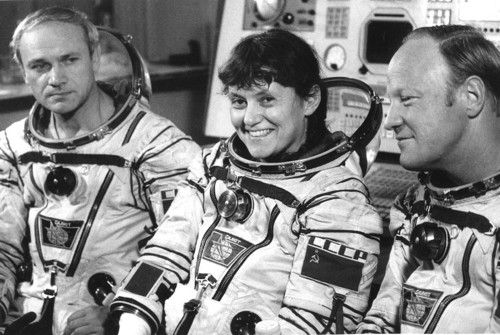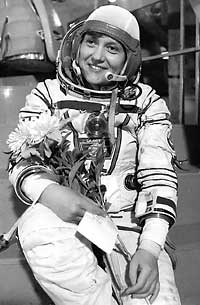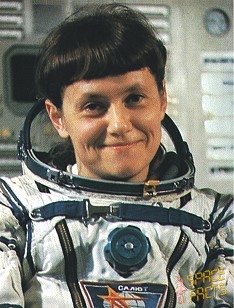This article is the second in a series of articles in which I will profile every woman astronaut, cosmonaut and taikonaut who has been into space. Last time we looked at the career of Valentina Tereshkova, the first woman in space. Today I’m profiling cosmonaut Svetlana Savitskaya, the second woman in space. (The feature image above is a collection of drawings of women astronauts by artist Phillip J Bond. You can find Phillip’s wonderful series on women astronauts here.)
Svetlana Savitskaya is a record breaking Russian aviator and cosmonaut.
Born in Moscow in 1948, Svetlana was raised in a middle class family. In high school she was a keen parachutist, and in 1970 she won 6th place in FAI (Fédération Aéronautique Internationale) World Aerobic Championship, went on to set 18 international world records in MiG aircraft, and set 3 international records in team parachute jumping. In 1974, Svetlana began a career as a pilot after urging from her father, a Deputy Commander of the Soviet Air Defences and World War II air hero. Her father had recognised her interest in flying and parachuting and was very keen for Svetlana to pursue pilot school. Just two years after finishing pilot school Svetlana went on to become a test pilot.In the late 1970′s the Soviet Union realised that the US was planning to send women into space within a few years. Svetlana noted that at the time, that although the Russians had the first woman in space (Valentina Tereshkova) they wanted to keep their record intact and beat the Americans once again. So they advertised and recruited a number of women candidates for cosmonaut school. In July 1980, 32 year old Svetlana was chosen for cosmonaut training. She successfully completed the arduous training programs for both the Salyut 7 (Russian Space Station) and Soyuz space craft.
After training, Svetlana was selected as a member of the 3 person crew for the Soyuz T-7 mission. This mission was to fly to the Salyut 7 space station, stay for approximately 7 days to conduct experiments and then return to Earth aboard the Soyuz T-5. The launch of Soyuz T-7 from the Baikonur Cosmodrome at 23:12 hours on 19 August 1982 was flawless. Svetlana, along with Leonid Popov and Alexander Serebrov flew aboard the Soyuz T-7 to dock with the Salyut 7 space station.
After docking with the Salyut 7 space station, Svetlana boarded the vessel only to be greeted by a fellow cosmonaut Valentin Lebedev, who subsequently gave her an apron and told her to ‘start work’. Despite what many cosmonauts thought, Svetlana was there to conduct experiments and throughout the mission she conducted experiments on the cardiovascular system, motion sickness, eye movement as well as an electrophoresis experiment on human cells. After 7 days, 21 hours and 52 minutes Svetlana and her crew returned to earth landing safely just 112 km northeast of Arkalyk. This trip resulted in Svetlana becoming only the 2nd woman in space at that time, and it was also the first human spaceflight by mixed female and male crew. Svetlana’s flight made her a national hero.
On the 17th of July 1984, on the 50th Soyuz spaceflight, Svetlana Savitskaya became the first woman to fly a second space mission when Soyuz T12 launched a mission to conduct maintenance operations on Salyut 7. During the mission Svetlana conducted various experiments and completed repairs to the space station. On 25 July 1984 Svetlana and Dzhanibekov donned their space suits and exited Salyut 7 to perform maintenance on the outside of the space craft. Their tasks involved cutting, welding and soldering tests on the outside of Salyut 7. Their space walk (or Extra Vehicular Activity) lasted 3 hours and 55 minutes. Svetlana had broken one more record, the first woman to conduct a space walk.
In a 2009 interview Svetlana, somewhat unsurprisingly, revealed that she battled sexism during her career in the Russian Air Force and within the Cosmonaut Corps. She noted that the ‘Missions were tough,’ and that ‘Even among our space colleagues the men wondered why we needed to weld and said that we might burn each other’s space suits, or the spaceship’s exterior. It’s a great responsibility. My spaceflight shut everyone up!’
Svetlana was twice awarded the Hero of the Soviet Union and has two asteroids named for her (4118 Sveta and 4003 Savitskaya), and her record of 2683 km/h in a MIG-21 in the female category remains unbroken.
Svetlana Savitskaya quote:
“When watching the Earth from over there, one can see the results of human activities, not just a beautiful bluish habitable planet, but because one can see just how habitable it is, with all of its floodlit streets and avenues, and its huge cities. One can see this both at night and in the daytime. And secondly, anyone over there, in orbit, should give, and actually gives, a thought to the fact that they are at an average altitude of 400 kilometres, aboard a space station or a spacecraft that have been manufactured by human mind and human civilization, so one can’t help but feel proud of them. One realizes that this planet is their home. One may even land on water, somewhere in the world Ocean, still the planet is their home. One has a natural psychological wish to return to earth, to their home. When in orbit, one thinks of the whole of the earth, rather than of one’s country, as one’s home.”
This article originally appeared in Australian Science!





